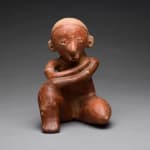Chinesco Style (Type C) Nayarit Terracotta Sculpture of a Seated Man, 300 BCE - 300 CE
Terracotta
15.9 x 10.8 cm
6 1/4 x 4 1/4 in
6 1/4 x 4 1/4 in
PF.2921
Further images
In the Nayarit tradition, simple images such as this seated male often had an underlying funerary symbolism, appropriate for their function as effigy figures in shaft tomb graves. The traits...
In the Nayarit tradition, simple images such as this seated male often had an underlying funerary symbolism, appropriate for their function as effigy figures in shaft tomb graves. The traits that characterize the Chinesco style of South-Western Nayarit (a flat, rounded, almost heart-shaped head, and thin eye slits) have been softened here, and the figure is more realistic in appearance. Both his head and his posture exhibit much less stylization than is generally seen in such figures. The remnants of ancient paint mark his small loincloth and necklace. He also appears to be wearing armbands, and the holes in his ears may once have held small ornaments. Great attention was given to detail in this piece, as even his toenails and fingernails have been carefully represented. The figure's right leg bends up to touch his folded arms, while his left leg is stubby and foreshortened, like those of typical Chinesco figures. Towards the end of the pre-classic period in Ancient Meso-America, the regions of Colima, Nayarit, and Jalisco in Western Mexico became home to what has now been termed the 'Shaft-Tomb' culture. These people built tombs consisting of shafts 10-60feet deep with several ovoid tombs branching either directly off of the main shaft at various levels, or connected to it by lateral tunnels. The burial offerings, which filled these tombs, have become our greatest link to this lost culture. The hollow pottery figures which were commonly placed in the tomb chambers show stylistic variations between regions, giving us glimpses into the cultural differences between these groups as well as the beliefs, which they held in common.





